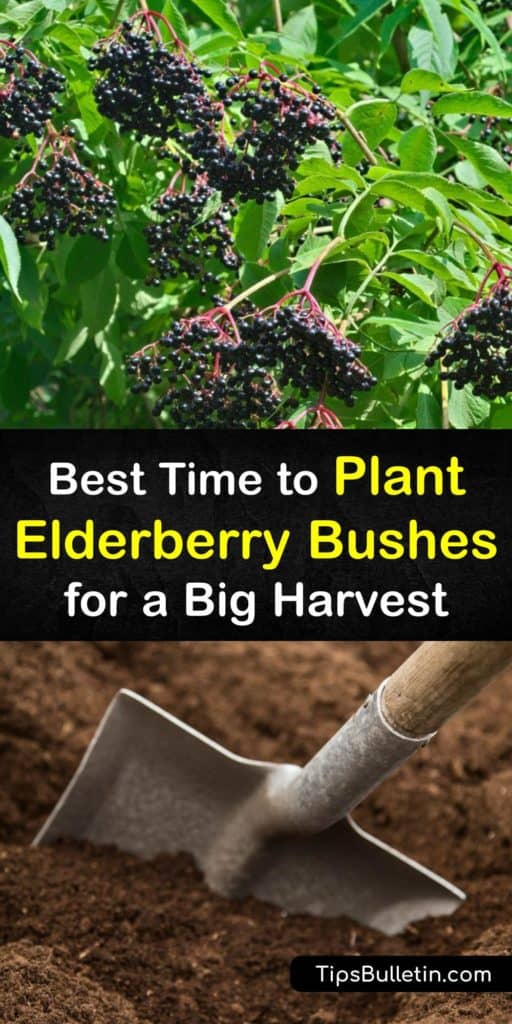Large elderberry plants start to line the ditches on the side of the road around August and September. If you have been in a lucky enough situation to eat these delicious, dark purple berries, know how exciting it can be when you decide to grow your own. For many gardeners, knowing when to plant elderberry bushes is crucial for you to have time to harvest them at the end of the growing season and turn them into elderberry syrup, jam, and other tasty recipes.
How do you know when to plant an elderberry bush based on your growing zone? This timeline doesn’t change too much throughout North America, but there are a few minor modifications some people must make.
Many factors influence how well these plants go. After reading this article, you’ll know not only when to plant elderberries but how to care for them and harvest them as well.

Things to Know before Learning When to Plant Elderberries
The elderberry growing season varies slightly based on the cultivars you choose and which species you prefer. The two most common elderberry bush plants are Sambucus canadensis, or the American elderberry, and Sambucus nigra, the European elderberry.
Within each of these groups are many different varieties too. Many of the most popular cultivars are native to the United States and are becoming common additions to gardens and lawns in these areas.
Before learning when to plant elderberry bushes, it’s good to have a little background on these plants. Elderberry shrubs are deciduous and not trees, even though many people refer to them as a tree.
When growing your own elderberry shrub, choose a cultivar that has needs that you can provide. Some of the most common that you can find in almost all USDA hardiness zones are Black Lace, Nova, York, Scotia, Kent, Johns, Adams, Black Beauty, and European Red elderberry plants.

Knowing when to plant an elderberry bush is crucial for its success. They are primarily hardy in zones three through seven.
Now that you understand the importance of picking a suitable cultivar, find the best time to plant elderberry trees in your growing zone.
When to Plant Elderberry Bushes
You can’t skip a step and start caring for your elderberry bush until you learn when to plant elderberries at the right time. Let’s take a look at the planting times for each growing zone.
When to Plant an Elderberry Bush
In general, it is best to plant elderberry seeds only after the risk of frost is gone in the early spring. This rule applies when to plant elderberries in zone 7 the same way it does for zone 3. Growing elderberry from cuttings is easy too.
For example, the last frost in zone 3 is typically around mid-May, while the last frost date for zone 7 is around mid-April. Transplant blackberry bushes at about the same time. Check your predicted frost dates online to ensure that the risk of frost is gone before sowing the seeds.
If you follow this rule, you’ll grow elderberries that are ready to harvest after their second year of life in the late fall. While the black berries do start fruiting the first year, they are much better to harvest after they have time to mature.
How to Grow Black Elderberry Plants
The location is equally as important as knowing when to plant an elderberry bush. Elderberry shrubs thrive when they’re in an area that gets partial shade.
Elderberries grow naturally in cool and moist areas rather than dry and hot ones. Proper drainage is vital to their success. Avoid places surrounded by standing water to protect their shallow roots.
These berry plants must be close to one another for the elderflowers to bloom. They use cross-pollination. Planting them in pairs that are no more than 60 feet away from each other is ideal for attracting pollinators to their white flowers.
Be careful not to plant each one too close, either. Adequate space is essential for air circulation between the shrubs, and it helps them fight off diseases like leaf borers. Elderberry plants grow up to 12 feet tall and six feet wide, requiring a lot of space. Most cultivars are not low lying shrubs and require adequate room.
Maintenance of Elderberry Plants
Gardeners are fans of elderberry shrubs because they require very little maintenance. They thrive in the wild, even after they are cut or sprayed by the local farmers. If they survive the first year, they’ll stick around for many years to come.
Plant elderberries in moist soil with a pH level between 5.5 and 6.6. They can handle a good amount of water for the first year of life as long as it drains away from the base of the plants.
They are bare-root plants that benefit when you fertilize them a few times per year. Use organic elderberry bush fertilizer or mix in some organic matter or compost for added nutrients to the soil.
Try to keep them out of the full sun if possible. If there is kryptonite for elderberries, it’s weeds.
Spread a very thick layer of mulch around the plants to keep weeds from growing and competing for resources. Rarely prune the shrubs unless you are trying to encourage new canes to grow.
Elderberries make great fast growing screening shrubs for spring and summer months but lose their leaves in the fall and winter.
Keep an eye out for bugs like aphids. This is one of the few problems with elderberry bushes but is easily treated with a strong stream of water from the hose or by sprinkling diatomaceous earth around the base of the plant.
Harvesting Elderberries
The most labor-intensive aspect of owning an elderberry bush is harvesting the fruit and roots. Roots should be cut in the late winter if you plan to propagate them the following year.
Harvest the black berries when they turn dark purple or black and are soft and juicy. They are unripe if they are hard, so hold off on pulling them to help them ripen a little more.
Try getting to the berries before the birds do. It’s not possible to pick individual berries. Cut the clusters as soon as they are close to being ready.
Cooking with Elderberries
Elderberries are full of helpful antioxidants and vitamin C, and their sweet flavor is a favorite in many kitchens.
Unfortunately, the seeds, stems, leaves, and roots have toxicity from cyanide-inducing glycoside. However, this issue goes away when the berries are cooked into tinctures, jams, or other treats.
Set the berries, water, cinnamon, cloves, and ginger in a saucepan and warm them over medium heat. Bring the entire pan’s contents to a boil, reduce the heat to low, and allow it to simmer for 30 minutes.
Mash the fresh elderberries with a potato masher and strain the liquid through a fine sieve. Discard the pulp and keep the juice. Let the juice cool, and then stir in the honey. Transfer the syrup to a lidded jar and keep it stored in the fridge for up to three months.
Finding out when to plant elderberries at the right time is the key to success. When these plants are given time to grow and adapt to their new environment, they provide you and the surrounding wildlife with fresh berries for years.

If learning when to plant elderberry bushes has surrounded your home with beautiful fruits, share these tips on when to plant an elderberry bush on Facebook and Pinterest.